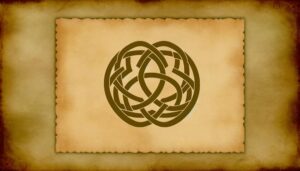Understanding the 6 Pointed Star Symbol and Its Meaning
The six-pointed star, known widely as the Star of David, carries profound historical and spiritual significance. Rooted in ancient civilizations, it symbolizes the harmony between opposites, as seen in its representation in Jewish tradition, alchemy, and occult practices.
In Judaism, it denotes divine protection and national identity. Alchemical traditions view it as emblematic of elemental balance and spiritual transformation.
It also appears in Islamic art, representing architectural harmony. This versatile symbol continues to represent interconnectedness and equilibrium across various cultural and spiritual contexts.
To understand its multifaceted meanings, one must explore its diverse historical and cultural applications.
Key Takeaways
- Represents harmony between opposites, symbolizing balance and interconnectedness.
- Known as the Star of David in Judaism, symbolizing divine protection and national solidarity.
- In alchemy, signifies the union of opposites and spiritual transformation.
- Used in various cultures to symbolize the connection between earthly and spiritual realms.
- Embodies sacred geometry, linking human consciousness to divine forces.
Historical Origins
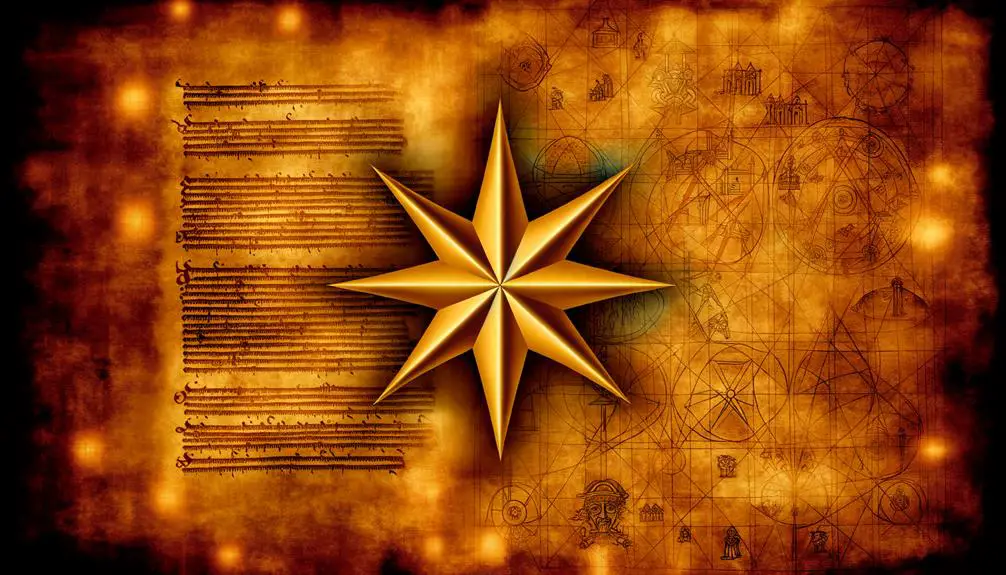
The historical origins of the six-pointed star symbol, commonly known as the Star of David, can be traced back to various ancient cultures and civilizations.
This geometric figure appears in archaeological finds from Mesopotamia around 3000 BCE, where it was used as a decorative motif.
In ancient Indian texts, the symbol is referred to as the Shatkona, representing the union of male and female elements. Similarly, it appears in Islamic art and architecture, illustrating its widespread cultural significance.
This hexagram also finds mention in medieval alchemical manuscripts, symbolizing the harmony between opposites.
The recurring presence of the six-pointed star across diverse historical contexts suggests its inherent symbolic versatility, transcending cultural and temporal boundaries.
Jewish Symbolism
In Jewish tradition, the six-pointed star, known as the Star of David or 'Magen David,' emerged as a prominent symbol, particularly in the medieval period, representing Jewish identity and faith.
This geometric figure, composed of two interlocking triangles, has been linked to divine protection, signifying God's shield over the Jewish people.
Its widespread adoption in Jewish communities was solidified in the 17th century, further establishing its role as a central emblem in synagogues, on tombstones, and in various religious artifacts.
The Star of David transcends its historical and religious origins, becoming a universal symbol of Judaism, particularly during the Holocaust and modern times, where it is emblazoned on the Israeli flag, signifying national and cultural solidarity.
Alchemical Significance
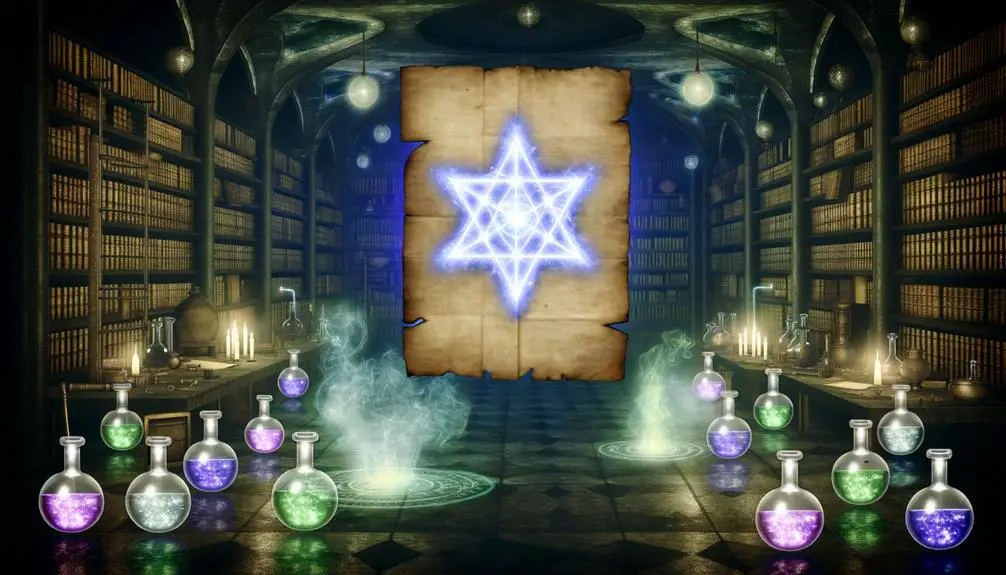
Within alchemical traditions, the six-pointed star, or hexagram, is often interpreted as a symbol of elemental balance, representing the harmonious integration of the classical elements: earth, air, fire, and water.
The interlocking triangles also signify the union of opposites, such as the material and spiritual domains, thus encapsulating the process of spiritual transformation.
This emblem holds a dual significance, illustrating both the equilibrium of natural forces and the aspirational journey toward spiritual enlightenment.
Elemental Balance Representation
A six-pointed star, often referred to as the hexagram, holds profound alchemical significance as it symbolizes the equilibrium of the four classical elements: earth, water, air, and fire. Each element corresponds to fundamental aspects of nature and human experience, and their balanced representation within the hexagram denotes harmony and unity.
The upward and downward interlocking triangles of the hexagram serve as metaphors for the integration of opposing forces—masculine and feminine, celestial and terrestrial. This geometric configuration encapsulates the alchemical ideal of achieving a state of perfect balance where elemental forces coexist in mutual support.
Therefore, the hexagram is not merely a symbol but a conceptual framework for understanding the interconnectedness and interdependence of all natural phenomena.
Spiritual Transformation Symbol
The hexagram, imbued with alchemical significance, serves as a potent symbol for spiritual transformation and the transcendence of the material domain.
This six-pointed star, often referred to as the Seal of Solomon, integrates two interlocking triangles. The upward triangle symbolizes fire and the masculine principle, while the downward triangle represents water and the feminine principle.
Their union signifies the harmonious integration of opposites, a core tenet in alchemical practice aimed at achieving spiritual enlightenment. This synthesis of elemental forces underscores the concept of achieving a higher state of being.
Alchemists viewed the hexagram as a map for the soul's journey, transforming base elements into spiritual gold, thereby transcending earthly limitations and attaining divine unity.
Occult Connections
Numerous occult traditions have imbued the six-pointed star, also known as the hexagram, with significant esoteric and mystical meanings. This symbol is often linked to a variety of metaphysical concepts and practices.
Its dual triangles, one pointing upward and the other downward, are interpreted as representing the union of opposites, such as:
- Male and Female Energies: Symbolizing the integration of masculine and feminine principles.
- Earth and Heaven: Indicating the connection between the terrestrial and the divine.
- Material and Spiritual Domains: Suggesting a balance between physical and spiritual pursuits.
- Alchemy: Often associated with the ancient practice of transforming base materials into noble ones.
These associations underscore the hexagram's role as a powerful symbol in various occult systems, enriching its multifaceted significance.
Cultural Variations
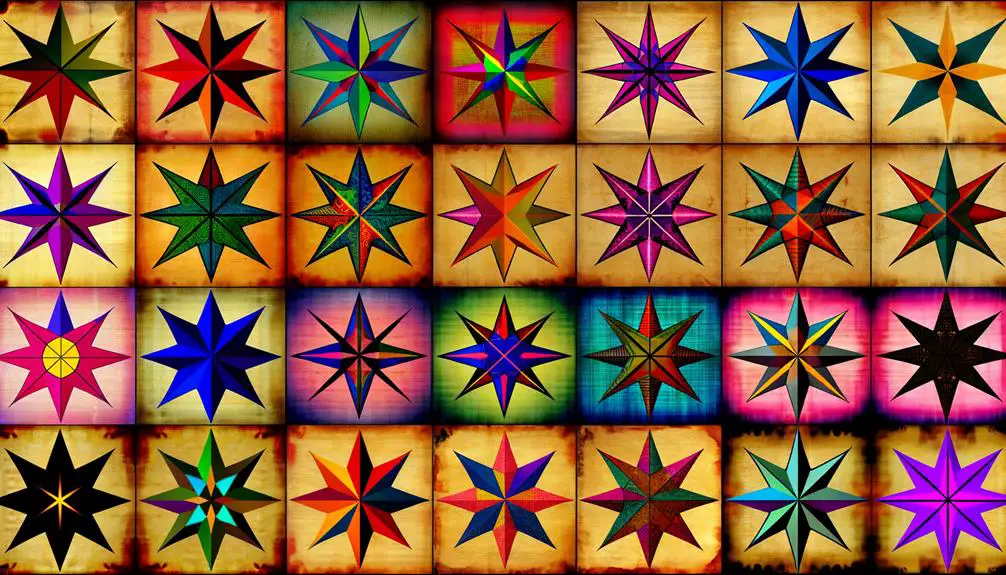
Across different cultures, the six-pointed star has been imbued with unique meanings and significance, reflecting diverse historical and social contexts.
In Judaism, it is known as the Star of David, symbolizing divine protection and identity.
In Hinduism, the star is associated with the merging of male and female energies, represented by overlapping triangles.
Islamic cultures sometimes use the star within architectural designs, emphasizing harmony and balance.
In medieval alchemy, it represented the union of opposites, such as fire and water.
These interpretations illustrate the star's adaptability, serving as a versatile symbol across various belief systems.
Understanding these cultural variations provides a richer appreciation for the six-pointed star's multifaceted symbolism throughout human history.
Modern Uses
Building upon its rich historical and cultural significance, the six-pointed star continues to find relevance in modern contexts, spanning from religious practices to contemporary design and branding. Its multifaceted applications illustrate its enduring versatility and symbolic resonance.
In contemporary settings, the six-pointed star is utilized in diverse ways:
- Religious Symbols: It remains central in Judaism as the Star of David, symbolizing Jewish identity and heritage.
- Military Insignia: Various countries incorporate the star into emblems and medals, signifying honor and distinction.
- Corporate Logos: Brands leverage its geometric symmetry to evoke balance, unity, and prestige.
- Art and Architecture: Artists and architects incorporate the star into designs to convey harmony and aesthetic complexity.
These modern uses underscore the six-pointed star's sustained cultural and symbolic significance.
Spiritual Interpretations
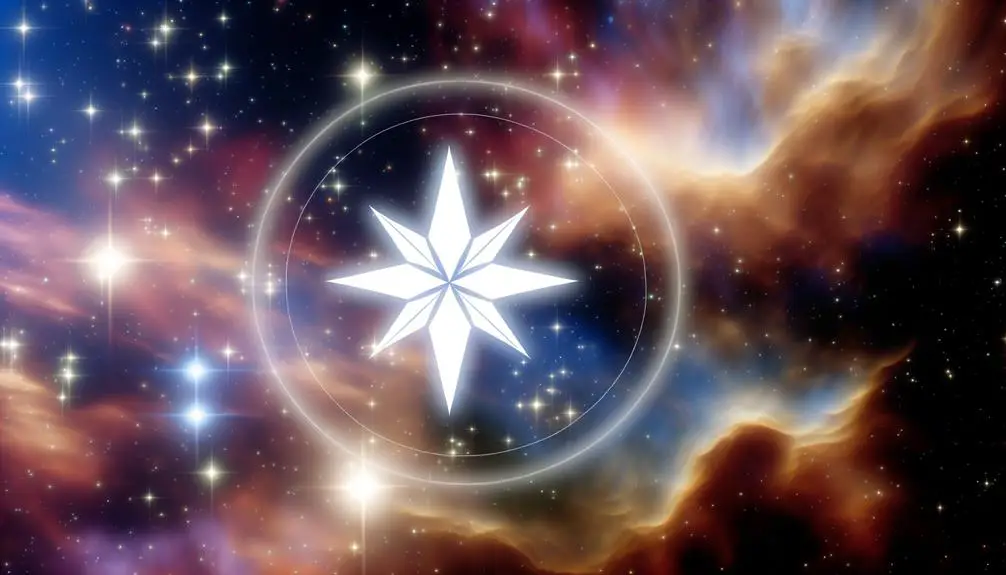
The six-pointed star, often referred to as the Star of David or hexagram, holds profound spiritual significance. It is commonly interpreted as a symbol of universal balance, representing the harmonization of opposing forces such as the divine and the earthly.
Additionally, this symbol is seen as a conduit for connection to divine forces, embodying the unity of spiritual and physical domains.
Universal Balance Symbolism
In spiritual interpretations, the six-pointed star, often known as the Star of David, is frequently seen as a representation of universal balance, reflecting the harmonious interplay between opposing forces. This symbol encapsulates the equilibrium between different elements and concepts, such as:
- Masculine and Feminine Energy: The upward and downward triangles symbolize the merging of male and female forces.
- Earth and Sky: The interlocking triangles represent the unity of terrestrial and celestial domains.
- Matter and Spirit: It signifies the balance between physical existence and spiritual essence.
- Dynamic and Static: The star denotes the equilibrium between movement and stillness, mirroring life's inherent duality.
Thus, the six-pointed star is a profound emblem of balance, essential for understanding the interconnectedness of all things.
Connection to Divine Forces
A profound manifestation of sacred geometry, the six-pointed star serves as a conduit connecting human consciousness to divine forces, symbolizing the intricate link between the earthly and the spiritual domain.
This geometric symbol, often referred to as the Star of David, embodies a synthesis of dualities—such as male and female, and heaven and earth—suggesting harmony and balance.
Its symmetrical interlocking triangles convey the concept of as above, so below, indicating a spiritual mirroring between higher planes and human experience.
Historically, various cultures have adopted this emblem to represent divine protection, enlightenment, and unity with the cosmos.
Hence, the six-pointed star transcends mere aesthetics, offering a profound spiritual resonance that underscores humanity's quest for divine connection and cosmic understanding.
Conclusion
The six-pointed star, or hexagram, has evolved to encompass a multitude of meanings across various cultures and historical periods.
While its most recognized association is with Judaism as the Star of David, the symbol also holds significant alchemical, occult, and spiritual interpretations.
Despite critiques that these diverse meanings dilute the symbol's clarity, the hexagram's multifaceted nature enriches its cultural and historical relevance, demonstrating its enduring versatility and profound impact on human symbolism.





